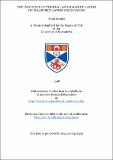Files in this item
The influence of thermal and magnetic layers on solar oscillation frequencies
Item metadata
| dc.contributor.advisor | Roberts, Bernard | |
| dc.contributor.author | Daniell, Mark | |
| dc.coverage.spatial | 176 p. | en_US |
| dc.date.accessioned | 2018-06-14T10:30:43Z | |
| dc.date.available | 2018-06-14T10:30:43Z | |
| dc.date.issued | 1998 | |
| dc.identifier.uri | https://hdl.handle.net/10023/14051 | |
| dc.description.abstract | In this thesis, a study is made of the global solar oscillations known as p-modes, modelled by a plane-parallel stratified plasma, within which is embedded a horizontal layered magnetic field. A magnetohydrodynamic formalism is used to investigate the models. The main aim of the thesis is to model the turnover effect in the frequency shifts of the p-modes observed over the course of the solar cycle. Radial oscillations (modes of degree zero) of the Sun are studied for several atmospheric temperature and magnetic field profiles. It is found that the turnover in frequency shifts may be obtained by an increase in the strength of the atmospheric horizontal magnetic field (assumed to be uniform), coupled with a simultaneous increase in atmospheric temperature. The effect of a thin superadiabatic layer in the upper convection zone on p-mode frequencies is also considered. For this model we study modes of general degree, and find that the observed rise and subsequent downturn in the frequency shifts can be duplicated, in the absence of a magnetic field, by simultaneously steepening the temperature gradient of the superadiabatic layer and increasing the atmospheric temperature. In the presence of a magnetic field, where the atmosphere is permeated by a uniform horizontal magnetic field, turnover is reproduced by a combination of an increase in magnetic field strength, a steepening of the temperature gradient in the superadiabatic region, and an increase in atmospheric temperature. The unstable superadiabatic layer also gives rise to convective modes, which are considered briefly. Finally, a model incorporating a magnetic layer residing at the base of the convection zone is constructed and its influence on the frequencies of p-modes assessed. By simply changing the magnetic field strength of this layer, we are unable to reproduce the observed solar cycle variations in p-mode frequencies. The buried magnetic layer supports surface and body magnetoacoustic waves, and a brief study is made of their properties. | en_US |
| dc.language.iso | en | en_US |
| dc.publisher | University of St Andrews | en |
| dc.subject.lcc | QA927.D2 | |
| dc.subject.lcsh | Magnetohydrodynamics | en |
| dc.title | The influence of thermal and magnetic layers on solar oscillation frequencies | en_US |
| dc.type | Thesis | en_US |
| dc.type.qualificationlevel | Doctoral | en_US |
| dc.type.qualificationname | PhD Doctor of Philosophy | en_US |
| dc.publisher.institution | The University of St Andrews | en_US |
This item appears in the following Collection(s)
Items in the St Andrews Research Repository are protected by copyright, with all rights reserved, unless otherwise indicated.

